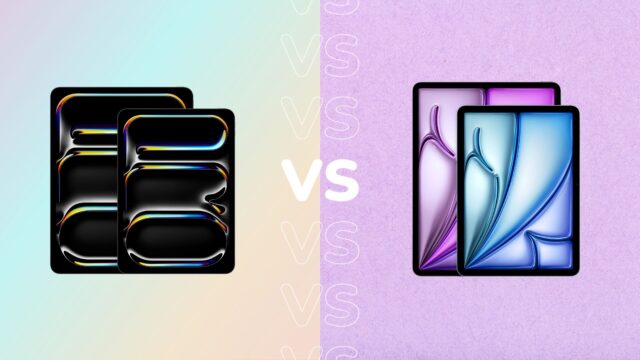Apple has just unveiled its latest premium tablet with the iPad Pro M5, which runs on the latest M-series chip.
Ahead of a full iPad Pro M5 review, we’ve compared its specs to the iPad Air M3, which we not only gave 4.5 stars, but also awarded the title of “best overall tablet” in our best tablets guide.
Keep reading to see what separates the iPad Pro M5 from the iPad Air M3. For more on Apple’s latest announcement, make sure you visit iPad Pro M5 vs iPad Pro M4 and iPad Pro M5 vs Samsung Galaxy Tab S11 Ultra.
Price and Availability
At the time of writing, the iPad Pro M5 is available to pre-order and will officially launch on October 22. Like its predecessors, the iPad Pro M5 is available in two sizes with the smaller 11-inch model starting at £999/$999 while the larger (but thinner) 13-inch version starts at £1299/$1299.
Much like the iPad Pro M5, the iPad Air M3 is available in two models: 11-inch and 13-inch. Perhaps unsurprisingly, the smaller 11-inch has a cheaper starting price of £599/$599, whereas the 13-inch version starts at £799/$799.
M5 vs M3
Both the iPad Pro and iPad Air run on Apple’s desktop-level M-series chips; however, they differ in their exact offering. While the iPad Air runs on the 2023 M3, the latest iPad Pro runs on the newer M5 processor.
Apple promises that the M5 chip will provide “next-level performance” and is ideal for “visually intensive applications and gaming”. Plus, the up to 10-core CPU, made up of six efficiency and four performance cores, is hailed as the “world’s fastest CPU core”.

Despite being a couple of years old, the M3 chip behind the iPad Air remains a perfectly capable processor. We found that the iPad Air M3 was able to manage plenty of tasks with ease, and even struggled to notice an obvious speed difference between it and the iPad Pro M4.
Not only that but the iPad Air M3 also supports hardware-accelerated ray tracing in certain titles too.
Keep in mind that although both the iPad Pro and iPad Air run on desktop-level chips, they remain somewhat limited by iPadOS. Although both are compatible with iPadOS 26, which includes the new Liquid Glass design and even more Apple Intelligence features including Live Translation, it still can’t run MacOS apps.


iPad Air M3 is available in more colours
Although it doesn’t offer such a bright palette of colours to choose from like the entry-level iPad, the iPad Air M3 is available in more choices than the iPad Pro M5. Users can choose between Space Grey, Starlight, Blue and Purple, although it’s worth noting that the latter shades are more pastel and subtle than their names might suggest.
In comparison, the iPad Pro M5 comes in just two colours: Space Grey and Starlight.
iPad Pro M5 colours
iPad Air M3 colours
iPad Pro M5 has an Ultra Retina XDR display
While we’re yet to review the iPad Pro M5, we’re quietly expecting big things from its display. Considering its specs suggest Apple hasn’t changed much from its predecessor, and we hailed that display as being a “triumph”, the iPad Pro M5 has a lot to live up to.
With an Ultra Retina XDR display, ProMotion technology and the option for a nano-texture display (but only for the 1TB or 2TB models), the iPad Pro M5 has been hailed by Apple as boasting “the world’s most advanced display”.
In comparison, the iPad Air M3 has a Liquid Retina display and, unfortunately, doesn’t boast ProMotion and instead caps out at a 60Hz refresh rate. The screen is good enough for everyday use, and is mostly on par with other tablets in its price range, but it certainly doesn’t offer as much oomph as the iPad Pro M4.


iPad Pro M5 supports fast charging
The iPad Pro M5 benefits from fast charging support, with speeds of up to 60W, which Apple promises will enable up to a 50% charge in around 30 minutes. As we’re yet to review the iPad Pro M5, we can’t confirm whether or not Apple’s claims are accurate. Even so, it’s undoubtedly exciting prospect, especially considering the iPad Air M3 doesn’t offer fast charging speeds.
iPad Pro M5 includes the N1 chip and the C1X modem
The iPad Pro M5 benefits from multiple Apple-designed technologies, which promise to enable the latest generation of wireless technologies and increase data performance.
There’s the N1 chip which was first introduced with the iPhone 17 series back in September 2025. The N1 chip is responsible for the running of Wi-Fi 7, Bluetooth 6 and Thread for controlling smart home devices from the device too.
Apple also promises that N1 will improve the iPad Pro M5’s overall performance and reliability within features such as Personal Hotspot and AirDrop too.
In addition, cellular iPad Pro M5 models are fitted with Apple’s C1X modem. Apple claims this should deliver “up to 50% faster cellular data performance” compared to its predecessor.
Early Verdict
As we haven’t reviewed the iPad Pro M5 yet, we’ll hold off from providing a conclusive verdict for the time being. Having said that, with its powerful M5 chip, faster charging and Ultra Retina XDR display, the iPad Pro M5 seems like a promising device for those who want a tablet for more than just everyday use.
However, if you plan on using your tablet for casual streaming, gaming and perhaps the odd day of light work, then the iPad Air M3 remains a brilliant and more affordable choice for many.










